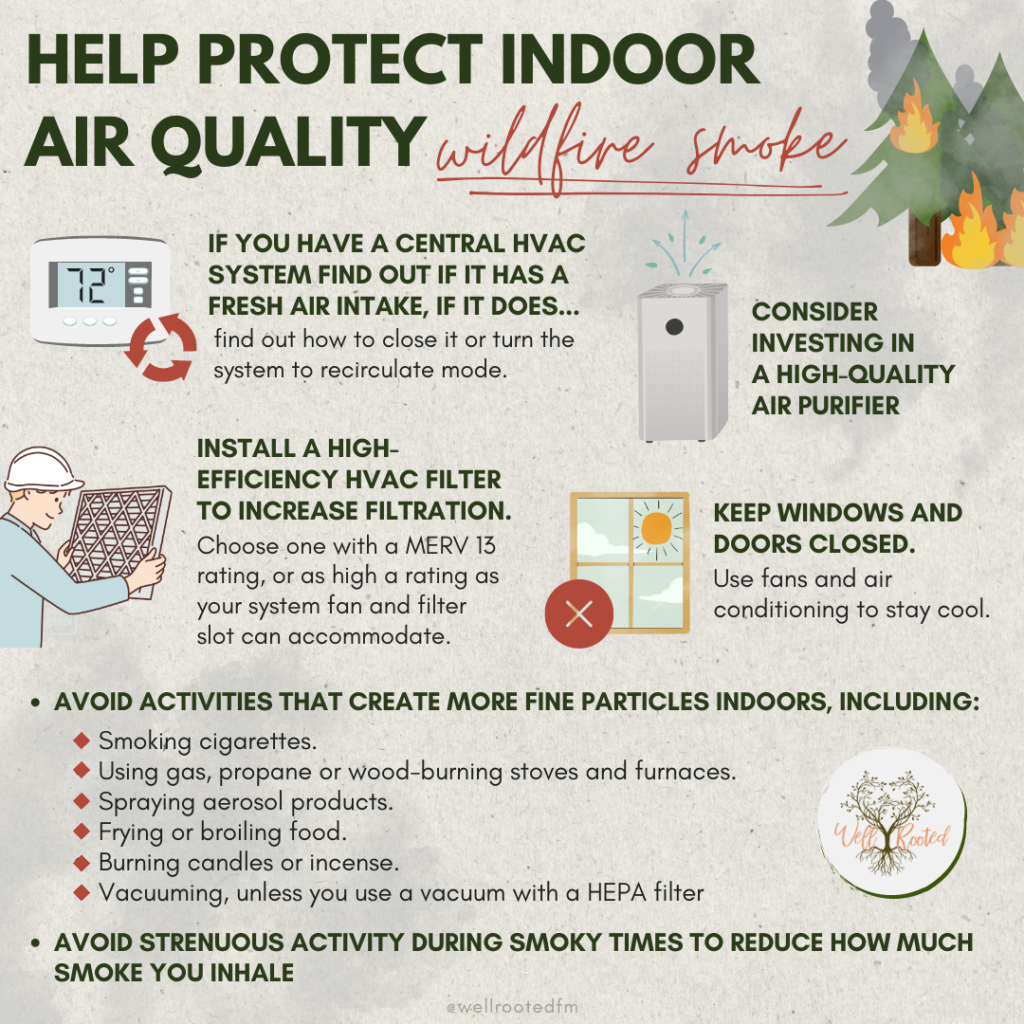Air quality alert! How can I help protect the air quality inside my home?

If you live in the Midwest, you may have noticed a campfire smell and/or smoky haze in the air the past few days... it's caused by smoke drifting into our area from the Canadian wildfires. 😞🔥
This week, the Great Lakes region – Chicago area specifically – had the worst air quality in the world.
According to AirNow, a government site that measures air quality, Northern IL was in the “very unhealthy” zone, which may cause sensitive individuals to experience adverse health effects. 😷
Poor outdoor air quality can cause health problems for many individuals, and toxins contained in the micro smoke particles are harmful to even the healthiest people.
People with heart 🫀 or lung disease 🫁, older adults 🧓👵, children and teens 👶👩🦱: Reduce your exposure by avoiding strenuous outdoor activities or keeping outdoor activities short. You may consider wearing a KN95/FFP2 mask. Strongly consider moving physical activities indoors or rescheduling outdoor activities if possible.
Everyone else: Reduce your exposure by choosing less strenuous activities or shortening the amount of time you are active outdoors.
💡 As we await relief from the smoky air, there are a few things we can do in our own homes to help create a safer air space for ourselves and our families.
Check out some of our top tips to help protect your home air quality in the graphic above.
And when driving in your car, keep windows closed and AC on recirculate. ♻️
The current air quality situation is a great time to check up on the quality of the air inside our homes.
According to the EPA, Americans, on average, spend up to 90% of their time indoors, where some pollutants may potentially have concentrations two to five times higher than outside.
💨 We commonly think of indoor air contaminants as being house dust mites and mold, carbon monoxide, second-hand tobacco smoke, radon, asbestos, and nitrogen dioxide. But your personal care products, your cleaning products, and even your carpets and furnishings may be leaking more hazardous toxins into your household and polluting the air you breathe.
These toxic pollutants may include VOCs (volatile organic compounds) such as benzene, chemical flame retardants found in furniture and/or rugs or carpet padding, and phthalates which are found in everything from personal care products and air fresheners.
🔺 VOCs can be emitted indoors through the odorous off-gassing from a variety of household items (paint, varnishes, sealants, flooring, pressed wood products, cleaners and disinfectants, furniture, air fresheners, cosmetics and deodorant). Breathing VOCs can irritate the eyes, nose, and throat, can cause difficulty breathing and nausea, and can damage the central nervous system and other organs. Some VOCs can cause cancer.
🔺 Phthalates are common contaminants in the indoor environment occurring both in house dust and in indoor air. PVC flooring is a big contributor to phthalates in indoor air. Phthalates are often found in indoor dust and can increase risk of asthma, allergy, and wheeze.
🔺Flame retardants in furniture are another often overlooked source of contaminants called PBDEs, or polybrominated diphenyl ethers. Exposure to PBDEs has been linked in laboratory tests to neurodevelopmental delays, obesity, endocrine and thyroid disruption, cancer and other diseases.
Learn to make informed choices for yourself and your family.
While some large changes like swapping our furniture or mattresses isn’t economical, you can:
- Choose to make your own cleaning products or purchase ones not filled with toxic chemicals
- Increase ventilation in your homes and workplaces
- Choose to freshen your space without harsh chemicals or artificial fragrances.

OUR LOCATIONS
Crystal Lake, IL
390 Congress Parkway Suite J, Crystal Lake, IL
Oak Brook, IL
814 Commerce Drive Ste 150 Oak Brook, IL 60523
HOURS OF OPERATION
Crystal Lake, IL
| Monday | 9am to 5pm |
| Tuesday | 9am to 5pm |
| Wednesday | 9am to 5pm |
| Thursday | 9am to 5pm |
| Friday | 9am to 5pm |
| Saturday | 1st, 2nd & 3rd Saturday Of The Month |
Oak Brook, IL
| Monday | 9am to 5pm |
| Tuesday | 9am to 5pm |
| Wednesday | 9am to 5pm |
| Thursday | 9am to 5pm |
| Friday | 9am to 5pm |
| Saturday | Closed |
Crystal Lake Office
390 Congress Parkway Suite J
Crystal Lake, IL
Phone 815-322-9300
Fax 815-322-9315
Email [email protected]
Oak Brook Office
814 Commerce Drive Ste 150
Oak Brook, IL 60523
Phone 815-322-9300
Fax 815-322-9315
Email [email protected]
Office Hours
Monday: 9am to 5pm
Tuesday: 9am to 5pm
Wednesday: 9am to 5pm
Thursday: 9am to 5pm
Friday: 9am to 5pm
Saturday: Varies By Location

